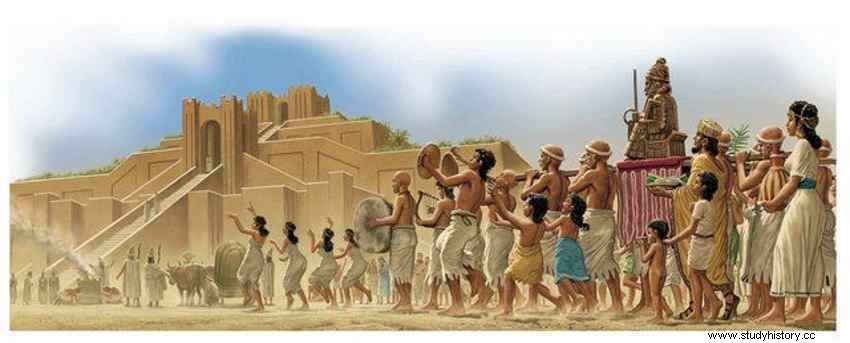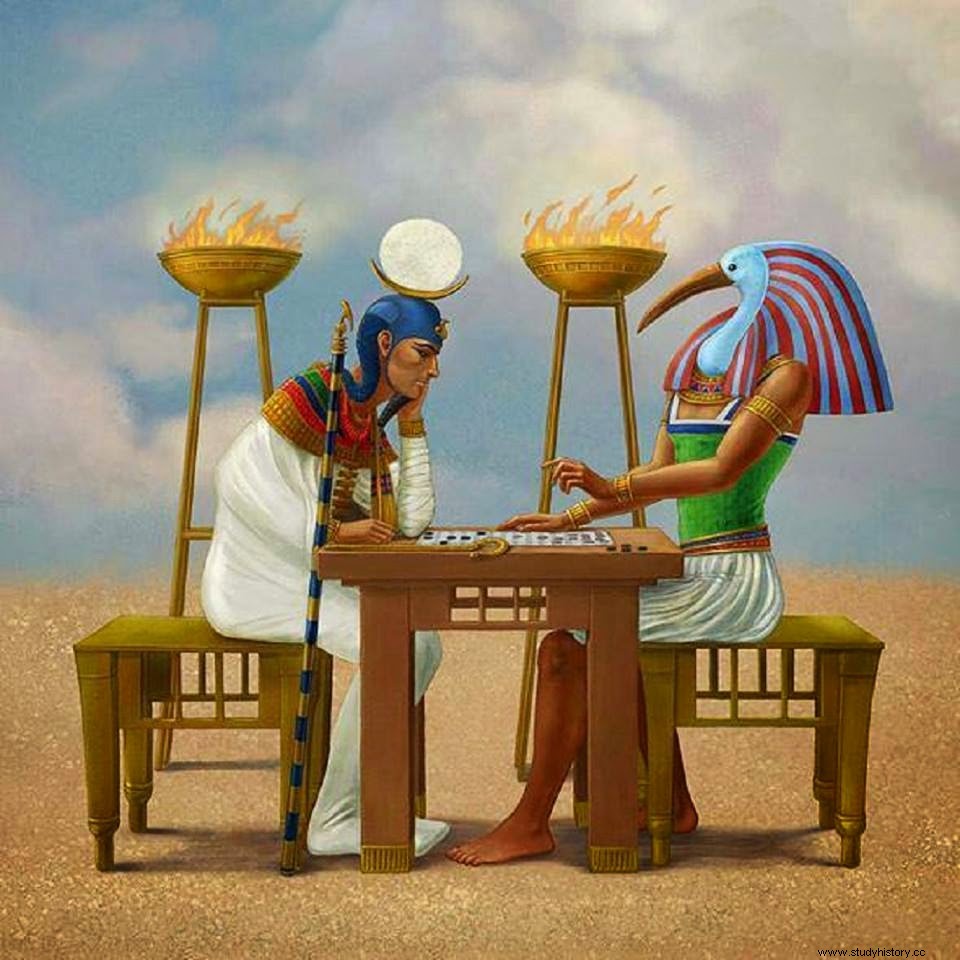On January 1 it seems appropriate to talk about the origin of our calendar and, for this, we have to go to the lands bathed by the Nile almost 5000 years ago.
The Egyptians divided the year into 12 months of 30 days (360) and 3 seasons of 4 months (Flood of the Nile or Akhet , seed or Peret and gathering or Shemu ), beginning the year with the onset of the Nile floods. You don't have to be a lynx to realize that this solar calendar was directly related to an eminently agricultural society. In addition, a year of 360 days made the Nile flood a few days earlier each year, since the movement of the Earth around the Sun lasts 365 days. And it is not a minor problem when your economy is based mainly on the flooding of the river. So they decided to pull the gods to "create" five new days which they called epagomenos:
According to legend, Geb (Earth) and Nut (Heaven) had married without the consent of their father Shu (Air). As punishment, he came between them so they couldn't be together. But it was late, because Nut was already pregnant, so Shu forbade every month of the year to allow Nut to give birth. But Thoth, the god of wisdom, took pity on them and helped them. In order not to defy Shu's prohibition, he challenged Khonsu (the Moon), in charge of measuring time, to play senet:each game won by Thoth would add one more day to the calendar. By winning five games in a row, five days were added and Nut was able to give birth to her children:Osiris, Horus the Elder, Seth, Isis and Nephthys.
And in this very original way, the Egyptian calendar passed to have 365 days. But there was still a small problem that would grow with time. For their part, the Romans had their own calendar since the founding of Rome in 753 BC. C. made up of 10 months (Martius, Aprilis, Maivs, Junius, Quintilis, Sextilis, September, October, November andDecember ) and 304 days. With the particularity of starting the year in the kalends by Martius (March 1), under the auspices of the warrior god Mars, since it was the date that marked the start of military campaigns with the appointment of consuls with an annual mandate. Logically, and just as it happened to the Egyptians but with more reason, the year was very short and both the appointment of consuls and the harvests danced capriciously over the years. Numa Pomplius, the second king of Rome after Romulus, partially fixed the problem by adding two months to the end:Ianarius and Februarius . Until Julius Caesar came…
Shortly before his death, the ides (15) by Martius (March) 44 a. C, and already as dictator, he brought the wise Sosigenes from his retirement in Alexandria to fix the same problem that the Egyptians had, since a new study reflected that the translation movement of the Earth around the Sun lasted not 365 days, but 365.25. So, as they say in my land, "turn the donkey to the wheat". That small margin of error determined that every four years the solar calendar deviated a day, and Sosígenes put it in time by adding a day every four years. And why is this day called a leap year? They are things of etymology, because leap comes from bis sextus (twice sixth), as it was added after Februaris 24 , which corresponded to the sixth day before the Kalends of Maivs . For the Romans, the month had three designated days:the kalends (from which the calendar derives) were the first day of the month, the nones were the 5th (except in March, May, July and October which were the 7th), and the ides were on the 13th (except in March, May, July and October which were on the 15th); the rest of the days were named on the basis of these three. For example, July 8 was Ante diem septimum Idus Iulias , seven days before the Kalends of July. It should be noted that adding a day every four years had already been introduced by the Egyptians in their calendar through the Decree of Canopus, but if Julius Caesar were not attributed these modifications it would be very difficult to justify changing the name of Quintilis by Julius and even that from that moment the Roman calendar was called Julian. Emperor Augustus would do the same with the month Sextilis …
While the emperor Augustus Caesar, in the month of Sextilis, was first admitted to the consulship, and thrice entered the city in triumph, and in the same month the legions, from the Ianiculum [mount of Rome], placed themselves under his auspices, and in the same month Egypt came under the authority of the Roman people, and in the same month the civil wars were ended; and that for these reasons said month is, and has been, the most fortunate in this empire, it is hereby decreed by the Senate that said month shall be called Augustus.
This calendar worked correctly until in 1582 it was discovered that Sosigenes' estimates were also slightly out of phase (the translation period was not 365.25 days but 365.2422 days). So, Pope Gregory XIII organized a commission of wise men (among whom was the Spaniard Pedro Chacón) who determined the following measures to adapt the calendar to the new reality:
– Years ending in two zeros whose first digits were not multiples of 4 would not be leap years. 1600 and 2000 were, but 1700, 1800, 1900 were not. A curious case is 4000, which being a multiple of 4, the commission determined that it would not it was a leap year (this last fact, personally, I don't care much).
– Skip ten days in the calendar. It went from Thursday, October 4 to Friday, October 15, 1582 (these ten days were lost in the course of history).
The loss of these ten days determined that those who died on October 4 were not buried until October 15 and that they were the ten quietest days in all of history. This calendar, called Gregorian, is in force today and was gradually adopted by all countries:first the Catholics, in 1700 the Lutherans (with eleven days behind the new calendar), in 1752 the English... and , finally, the Greeks in 1927 (thirteen days late). The disparity of criteria when adopting the Gregorian calendar gave rise to Cervantes and Shakespeare dying on the same day (ten days apart), although only nominally, because Spain and England were governed by different calendars, or that a month of February had thirty days in Sweden.
Sweden's ingenious idea to catch up with the other countries that followed the Gregorian calendar without having to suppress the eleven days all at once in its case, was to adapt gradually:starting from 1700, and without adding the extra day of the next eleven leap years, they calculated that in 1740 it would already be equated with the new calendar. When they began to apply this brilliant measure, in 1700, they realized that at that time they were one day out of step with those who continued with the Julian and ten with those who already applied the Gregorian, with the consequent problems in any commercial agreement or international politician. So, in 1712, they decided to go back and return to the Julian:the day they had removed in 1700—in 1704 and 1708 it hadn't been removed anymore—they put it back in 1712, also a leap year, so their February that year had thirty days. So they returned to the Julian, until in 1753 they adapted to the Gregorian, removing eleven days... all at once.
And we will end with the new year in Sumeria.

Imagine thousands of people in a big city making love in the streets. Are we in a porn screenwriter's dream? Well no. We will be in a Sumerian city during the New Year's party. The Sumerians only considered two seasons:summer and winter. The New Year was celebrated at the beginning of the summer, coinciding with what for us would be the end of April.
The New Year festival was in honor of the goddess Inanna (later Ishtar), goddess of love, sex and war. Inanna was never a mother goddess as some believe; in fact, she didn't even have children. She was the young rebel of the Sumerian pantheon. Smart and willing to learn from mistakes; but she also has a great personal ambition, compassion towards humans and at the same time a very vengeful character. On one occasion, after being raped by a gardener, she launched a series of plagues against humanity:water that turns into blood, rain of frogs and locusts, skin ulcers... What does this sound like to me? Where have I read it before? The festival commemorated the descent of the goddess to hell, where she crossed its seven gates, leaving a garment in each one and delivering her own body in the last one, after which she died. However, on the third day she was resurrected and returned triumphantly to the world more powerful than ever —it sounds familiar to me and I don't know what. In early versions of the myth, Inanna finds her husband, Dumuzi, in the middle of a party and angrily kicks him to hell. In more modern ones, the myth had been decaffeinated and she is a submissive and enamored wife who goes down to hell to save her husband instead of becoming a supergoddess.

Inanna from my countryman Luis Royo
For the Sumerians, sex was a fundamental part of life, so in those days it was practiced, and a lot. It is thought that it was also a way of achieving synchronization of births, as it would be attempted to ensure that a large part of the women became pregnant by giving birth at a time of year when, once the harvest had been harvested, the babies could be better cared for. Depending on the cities, the festival lasted more or less days - the average was a week. Throughout these days public banquets were held at the expense of the temples or the ruler's palace, and music recitals and solemn processions were organized during which gifts were thrown to the crowd. The central act of the New Year was the hierogamy or sacred marriage ceremony. During this, the ruler went inside the temple and, before the divine statue, slept with the high priestess, at which time her powers of command were transmitted to him. In fact, it is thought that most of the time the sex was feigned, since it is known of cases in which said high priestess was the daughter of the ruler and for the Sumerians incest was a terrible crime. Whether it was real or fake depended on the times and the cities. There were cases in which the high priestess became pregnant and her child was given a semi-divine character. Keep in mind that it was not shameful to be a single mother. In fact, Sargon of Akhad, great conqueror and founder of the Akkadian dynasty, boasted in his biography that he was the son of a single mother, who had abandoned him in a basket in the river and was adopted by a member of the royal court. of Kish who found it (something similar is also told about a certain Moses).
After hierogamy, everyone made love, either with their better half or with the hierodulas (sacred prostitutes). Nor was it frowned upon to make love on those days with the lover on duty. Men could have concubines and mistresses, and women could have mistresses as long as the husband gave her permission. And it seems that it was usual for them to give it; In addition, it did not matter if the woman became pregnant, because for the Sumerians children were fundamental and the husband had no problem adopting the offspring, who had all the rights of a natural child. In his mind, the loser was the lover who was left without a child and the winner was the husband who got one more child. As they were very uninhibited people, it was not strange to see couples doing it even in the streets. They drank beer, sang and made love... And they didn't even have to confess or feel guilty about it.
No wonder it was the most important holiday in the Sumerian religion!

